Translate this page into:
Role of botanical leaves powder in blood hematology of living organisms
⁎Corresponding author. abashir@gudgk.edu.pk (Muhammad Amjad Bashir)
-
Received: ,
Accepted: ,
This article was originally published by Elsevier and was migrated to Scientific Scholar after the change of Publisher.
Peer review under responsibility of King Saud University.
Abstract
The current study was directed to examined the two excellent herbal plants Azadirachta indica and Moringa oliefera leaf powder as an alternative to antibiotic growth promoters on the growth performance in terms of (FC, LWW, BWG, FCR and mortality rate), blood biochemistry (WBC, RBC, MCHC, MCH, MCV, LYM, GRA, MID and HCT) and carcass characters weight performance (Carcass Components, Yield of Main Carcass Parts (%), Giblets weight (%) and visceral organs weight (g). Feed conversion ratio measured is significantly (p < 0.05) different in treated groups and in the control group. Highest FCR was recorded in control group as compared to supplementary groups. Low FCR recorded in treated groups show significant (p < 0.05) results. The CBC analysis of the supplementary treatments and the control group show significant (p < 0.05) differences in WBC, RBC, MCHC, MCH, MCV, GRA and LYM. Treated groups had higher concentration of these parameters than the control groups but non-significant results obtained in terms of HGB, MID and in HCT concentrations. Carcass Characters show significant (p < 0.05) differences in the Carcass Components, Giblets Weight and in Visceral Organs Weight in supplementary treated groups as compared to control group.
Keywords
Neem
Moringa
Blood hematology
Growth chicken
1 Introduction
A well-secure diet is that provides ample health, growth and development. To ensure that all essential nutrients are consumed, food must contain a wide variety of ingredients. We need to fodder the bodies with energy, standard amino acids, and a variety of minerals and vitamins to stay healthy. For sustaining appropriate balance of nutrient intake every culture involves intake of a mixture diet that can’t be attained from single food ingredient consumption. The consumption of meat and human health association is multidimensional. Broilers are dictating the sphere in last recent decades due of high demand of broiler meat and eggs. Meat of chicken is vital component of a fit and well balanced diet because of multiple nutritional richness with sensible contented energy, vastly edible proteins of good nutritional worth, minerals (Cu, Fe, and Zn), lipids mainly unsaturated (that are found in the skin and are easily removed), B-group vitamins (mostly Vit B6, pantothenic and thiamin) (Aashaq et al., 2019). Poultry meat is the most proficient and economical converter of vegetable food into animal protein. The easiest and cheapest spring to harvest protein is chicken (Udoh and Etim, 2007; Alam et al., 2015) (see Figs. 1–3, Tables 1–3).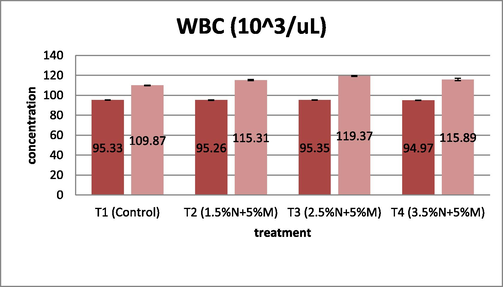
Representing WBC (10^3/uL) concentration in broilers by the supplementation with Azadirachta indica and Moringa oliefera leaf powder.
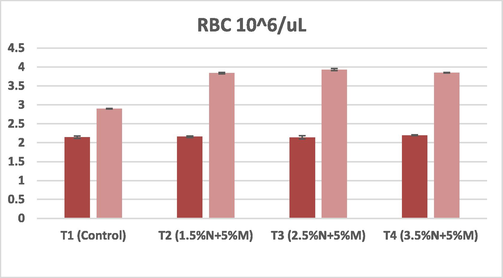
Representing RBC (10^6/uL) concentration in broilers by the supplementation with Azadirachta indica and Moringa oliefera leaf powder.
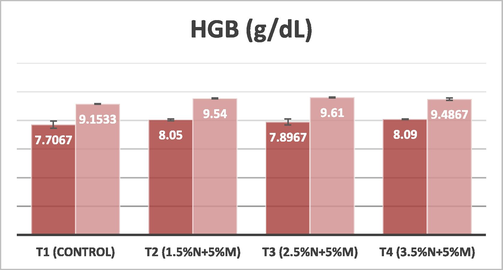
Representing HGB (g/dL) concentration in broilers by the supplementation with Azadirachta indica and Moringa oliefera leaf powder.
Sr. No
Groups Name
Feed %
1
Treatment-T1
Untreated control group
2
Treatment-T2
1.5%Neem + 5%Moringa
3
Treatment-T3
2.5% Neem + 5% Moringa
4
Treatment-T4
3.5% Neem + 5% Moringa
SOV
Df
SS
MS
F-Value
P-Value
Weeks
1
2371.684017
2371.684
3046.5933
0.0000**
Treatments
3
68.9067
22.9689
29.505152
0.0000**
W*T
3
70.13815
23.379383
30.032446
0.0000**
Error
16
12.45553333
0.7784708
Total
23
2523.1844
SOV
Df
SS
MS
F-Value
P-Value
Weeks
1
12.98010417
12.980104
5779.6382
0.0000**
Treatments
3
1.110945833
0.3703153
164.88992
0.0000**
W*T
3
1.0345125
0.3448375
153.54545
0.0000**
Error
16
0.035933333
0.0022458
Total
23
15.1614958
They are highly desired by the many millions of people who live in paucity and play critical roles in the global fight against hunger. Broiler production has evolved into a significant economic activity with a wide range of business interests, including broiler production, egg production, hatcheries, and poultry equipment business (Padhi, 2016). The poultry farming is gainful mainly because it necessitates less space for rearing and breading, quick returns of investment, (Oluyemi and Roberts, 1979) higher weight gains, feed mills springing up and its publication age is smaller (Tipu et al., 2006) (see Figs. 4 and 5, Tables 4 and 5).
Representing MCHC (g/dL) concentration in broilers by the supplementation with Azadirachta indica and Moringa oliefera leaf powder.
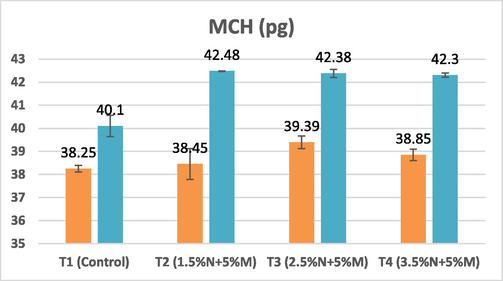
Representing MCH (pg) concentration in broilers by the supplementation with Azadirachta indica and Moringa oliefera leaf powder.
SOV
Df
SS
MS
F-Value
P-Value
Weeks
1
13.71081667
13.710817
317.0742
0.0000**
Treatments
3
0.553766667
0.1845889
4.2687737
0.02150*
W*T
3
0.087883333
0.0292944
0.6774587
.578Ns
Error
16
0.691866667
0.0432417
Total
23
15.04433333
SOV
Df
SS
MS
F-Value
P-Value
Weeks
1
3.33015
3.33015
70.929712
0.0000**
Treatments
3
1.287033333
0.4290111
9.1376169
0.0009**
W*T
3
0.799416667
0.2664722
5.6756597
0.0076**
Error
16
0.7512
0.04695
Total
23
6.1678
Pakistan's poultry industry contributes significantly to closing the supply–demand gap. The poultry industry is in good health and is in high demand, particularly in developing countries like Pakistan. It accounts for 26.8% of Pakistan's total meat production. >1.5 million people in Pakistan benefit from the poultry industry, which employs them and provides them with a source of income. Over 20,000 poultry farms can be found in rural areas across the country (Gadde et al., 2017) (see Figs. 6–8, Tables 6–8).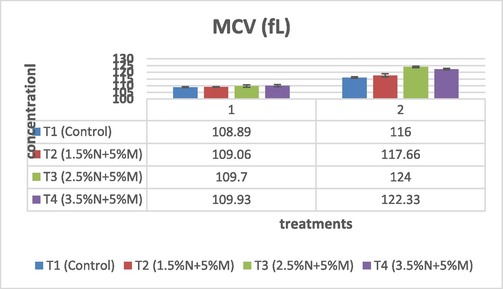
Representing MCV (fL) concentration in broilers by the supplementation with Azadirachta indica and Moringa oliefera leaf powder.
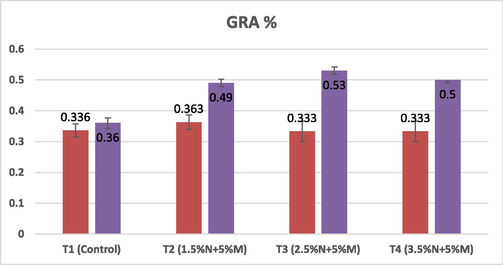
Representing GRA % concentration in broilers by the supplementation with Azadirachta indica and Moringa oliefera leaf powder.
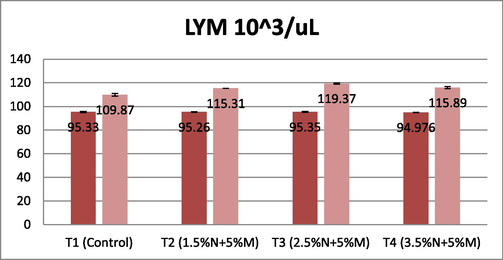
Representing LYM (10^3/uL) concentration in broilers by the supplementation with Azadirachta indica and Moringa oliefera leaf powder.
SOV
Df
SS
MS
F-Value
P-Value
Weeks
1
56.98001667
56.980017
176.98406
0.0000**
Treatments
3
10.3093
3.4364333
10.673811
0.0004**
W*T
3
3.849216667
1.2830722
3.9853152
0.0269*
Error
16
5.1512
0.32195
Total
23
76.28973333
SOV
Df
SS
MS
F-Value
P-Value
Weeks
1
674.4780375
674.47804
450.88319
0.0000**
Treatments
3
81.2017125
27.067238
18.094232
0.0000**
W*T
3
49.69504583
16.565015
11.073581
0.004**
Error
16
23.93446667
1.4959042
Total
23
829.3092625
SOV
Df
SS
MS
F-Value
P-Value
Weeks
1
0.1053375
0.1053375
71.821023
0.0000**
Treatments
3
0.029279167
0.0097597
6.6543561
0.0040**
W*T
3
0.0275125
0.0091708
6.2528409
0.0052**
Error
16
0.023466667
0.0014667
Total
23
0.185595833
Chickens are classified as class Aves, Galliformes order, Phasianidae family and genus Gallus. The general morphological characteristics of class Aves include feathers, vertebral column, light weight bones, and horny bill with the exception of teeth. Their major characteristics include increased metabolic rate and endothermic nature. Chickens are omnivores, and modern broilers are fed a high-protein diet that is normally delivered by an automated feeding system. Four to seven weeks of broilers attain two kilogram weight and sometimes take fourteen weeks to reach the slaughter weight due to slow growth rate capacity. It's critical to get enough nutrition to get the most out of your workout.
This is the discounted font of high value protein. The health of the broiler is crucial. They are omnivores, enjoying a wide diversity of foods like herbs, fruits, vegetables and grains. The demand of country for meat production has increased because of increased human population. Aside from the danger of an ever-increasing population, disease blowout, and high food costs, some of the features that bound broiler production presentation include the lack of quality ingredients for balanced feed formulation and the lack of convenience of quality constituents for balanced forage formulation. As a result, farmers are stimulated to use advance promoters and other food spices to overwhelmed nutritional deficits in order to withstand an optimal progress level in poultry.
Broiler businesses have auspicious future, but they are also plagued by diseases and microorganism attacks that cause substantial mortality and stunted growth, resulting in a shortage of animal protein supply and availability (Alabi and Isah, 2002). Antibiotics are used to progress overall performance and immunity rank by eliminating stress. Antibiotics are used to destroy lethal attacks of microorganisms and to defend the body against harmful diseases to eliminate them and promote the growth of the chicken (Gadde et al., 2017). Some of these chemicals are prescribed for chemotherapeutic and preventive purposes, while others are said to promote growth.
Broilers are given antibiotic growth promoting hormones (AGP) and a variety of synthetic medications to promote rapid growth, increased livability, and lower death rate, high FCR in poultry birds, as well as to boost the economic output of livestock producers. They're utilized as a fodder addition to control maladies and for the improvement of gut health and that aren't yet clinical. Virginamycin, Monensin, Avilamycin, Enramycin, and Bacitracin methylene disalicylate (BMD) are some of the most often used AGP in the poultry sector (Danzeisen et al., 2015). Antibiotics include lincomycin, chlortetracycline, avoparcin, penicillin-G-procaine, virginiamycin and bacitracin stimulate growth via affecting the thymus gland (Deman, 1975). Synthetic pharmaceuticals as antibiotics and as promoters of growth come at a high price tag, and they often have negative side effects on bird health, a protracted withdrawal period, and the possibility of accretion in eggs and tissues, all of which can be damaging for the health of human (Jawad et al., 2018).
Many countries and farms have placed restrictions on the use of AGP for these reasons. Monensin, sodium, salinomycin sodium, avilamycin, flavophospholipol, and other widely used feed antibiotics have been banned by the European Commission. Nutritionists used to alternate the AGP to solve the problem and reduce the use of antibiotics because of the restriction on AGP (El-bashier and Ahmed, 2016; Swain et al., 2017; Mashayekhi et al., 2018). The prohibition on synthetic feed additives has prompted extensive research into alternative strategies for maintaining health and performance in intensive poultry production systems. Antibiotics may be replaced by enzymes, probiotics, prebiotics, immune stimulants, organic acids, phytobiotic stimulants, organic acids, and some herbs, medicinal plants, and spices (Windisch et al., 2008). Ethno-veterinary medications, herbs and outmoded or native plants have long been used for body and mind bolstering due to their numerous benefits (Rios and Recio, 2005; Mirzaei-Aghsaghali, 2012). Remedial foliage are a valuable wellspring of constituents that are said to stimulate immunomodulation nonspecifically such macrophages, as natural killer cells, granulocytes and complement functions(Mirzaei-Aghsaghali, 2012) (see Figs. 9 and 10, Tables 9–11).
Representing MID (10^3/uL) concentration in broilers by the supplementation with Azadirachta indica and Moringa oliefera leaf powder.
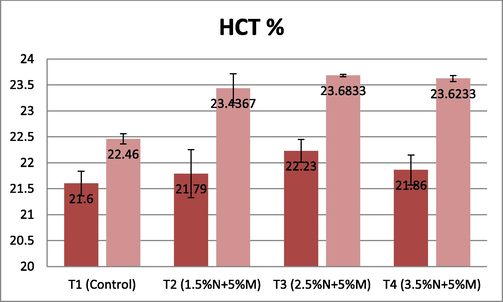
Representing HCT % concentration in broilers by the supplementation with Azadirachta indica and Moringa oliefera leaf powder.
SOV
Df
SS
MS
F-Value
P-Value
Weeks
1
1917.451267
1917.4513
991.53725
0.0000**
Treatments
3
40.45288333
13.484294
6.9728918
0.0033**
W*T
3
24.44903333
8.1496778
4.214297
0.0224*
Error
16
30.94106667
1.9338167
Total
23
2013.29425
SOV
Df
SS
MS
F-Value
P-Value
Weeks
1
15.0258375
15.025837
292.21303
0.0000**
Treatments
3
0.468079167
0.1560264
292.21303
0.0597 ns
W*T
3
0.257745833
0.0859153
1.6708262
0.2132 ns
Error
16
0.822733333
0.0514208
Total
23
16.57439583
SOV
Df
SS
MS
F-Value
P-Value
Weeks
1
12.21226667
12.212267
66.037537
0.0000**
Treatments
3
2.832183333
0.9440611
5.1049876
0.0114*
W*T
3
0.721933333
0.2406444
1.301279
0.3083 ns
Error
16
2.958866667
0.1849292
Total
23
18.72525
These alternatives have proven to be natural, less hazardous, and residue-free feed additives in the foodstuff animal trade. They have a good influence on the health and growth of animals (Ayden et al., 2020). They have cheaper production costs, lesser toxicity risks, and fewer health dangers. Also the reduction in the death rate, by increasing feed efficiency, enhanced immunity, enhancing livability and by increasing the weight gain in broiler chicken has also showed promising outcomes. They have hunger and feed intake stimulation, improved endogenous digestive enzyme secretion, immunological response activation, antibacterial, antioxidant, antiviral, and anti-helminthic activity. Innumerable herbal products in the poultry provisions like Moringa, Neem, Black pepper, Ginger, Peppermint, Cardamom, Cumin, Anise, Aloe Vera, Eucalyptus, Tulsi, Cloves and many others are being used as growth promoters (Chowdhury et al., 2018). These herbal formulations due to their medicated properties do not have any residual possessions.
Neem has a significant number of physiologically active chemicals that are both chemically and structurally varied. From various portions of the neem plant, >140 chemicals have been identified. Seeds, Roots, Flowers, bark, and especially leaves of the neem tree have long been used as an antidote for infection, fever, inflammation, as for dental disorders, and skin diseases (Durrani et al., 2008). The tree is ideally suited to the tropical rainforest's climatic and soil requirements. The leaves of the Neem plant have a garlic-like odor and a bitter flavor. The neem plant's appeal stems from the fact that it is an inexpensive herbal plant that is non-toxic to both animals and people, as well as helpful in contradiction of malaria. Azadirachta indica leaves also contain chemicals that have been shown to have antibacterial assets. Extracts of neem leaves have been shown to have antibacterial activity counter to bacteria for example Escherichia coli, Pseudomonas, Staphylococcus and Streptococcus species as well as several fungal strains (Koona and Budida, 2011).
The Moringa tree, sometimes known as the Miracle Tree, has a wide range of medical applications due to its hypocholesterolemic qualities. Leaf of Moringa oleifera have protein level ranged from twenty to twenty three percent dry weights and is of excellent grade. With certain important amino acids, vitamins, minerals, high concentrations of necessary nutrients, fatty acids, and fiber with good potential as antioxidants, the ease of establishment is both nutritional and medical, firming up the immunity. Almost all components of this plant, including the gum, seed, seed oil, root, fruit, bark, and especially the leaves, are edible and have been used in traditional human diet. It's used for a variety of things. In indigenous medicine, it is used to treat a variety of maladies, including inflammation and viral infections, as well as haematological, gastrointestinal, cardiovascular, and hepatorenal issues. Beta-carotene, protein, vitamin C, magnesium, iron, calcium and copper are all abundant in moringa leaves (Yang et al., 2006).
2 Material and methods
The purpose of the current study was to evaluate the effect of Azadiratcha indica and Moringa oliefera leaf powder on blood haemotology of broiler chicken. The leaves of Azadiratcha indica and Moringa oliefera were mixed with the basal diet of the broiler chicken.
2.1 Collection and preparation of leaves
Supplemented feed was chosen for its ability to lift growth in broiler chickens. Moringa (M) and Neem (N) fresh leaves that were mature and disease-free were taken from neighboring village trees. These leaves were rinsed in clean drinking water before being laid out to dry on sheets. The dried leaves were collected after ten days in the sun. The stem component of the leaves was separated from the dried leaves. The leaves were crushed by hand and then saved as stock to be ground later. After all of the leaves had dried, a hammer mill was used to ground them into a fine granular powder.
2.2 Experimental birds
A total of two hundred (200) vaccinated four-day-old broiler chicks were procured from commercial and Breading Hatchery farms of Multan. After arriving, the chicks were numbered and handled with care. Their original body weight was measured by a weight machine before they were placed in wood crates. Three weeks of acclimatization were given to the chicks (21 days). 25-day old chicken of uniform body weight were subjected to varying conc. of Neem and Moringa separated into four groups with respect to different conc. of (N) and (M) per group after a 3-week acclimatization period.
2.3 Experimental design
To verify the effect of Neem and Moringa leaf powder has any effect on broiler chickens. The chicks were allocated into four major groups and with their triplicates were labeled (T1, T2 T3 and T4). Each treated group received three (15-chicks) sessions (9 treatments). For 35 days of testing, group T1 was deemed as control with no supplements of (N) and (M) fed only basic fodder wheat, rice, and millet, while the treatments T2, T3 and T4 were supplemented with Moringa (M) and Neem (N) at varied percentage rates added in to the drinking water in addition to basic feed. The feed was applied according to the Dera Ghazi Khan veterinary hospital standard scale in broiler chicks as shown in feed intake chart tables given below.
2.4 Management procedures
The proper supply of water, food, light, temperature, cleanliness, and survivorship were monitored and recorded for thirty five days of age on a daily basis for the management of the experimental setup. A thermometer was used to record the room temperature (°C) every six hours to maintain the arrangement. To increase the feed intake and for the body growth light was provided in the broiler chamber at night. The light was provided on 24 h a day during the first two weeks of age. Following that, 22 h of light and 2 h of darkness were set. Rice husk was applied at 3 cm of depth for litter management. During 2nd week of age, top surface infestations of the clutter were removed, and in place new were supplied as needed. Food and clean, fresh water were provided to the birds. For 15 birds, each box featured a feeder and a round drinker. Drinkers were cleansed every day, whereas feeders were cleaned once a week. Ventilation is required to remove toxic gases from the farm birds. Room windows contribute in the ventilation process. The elimination of gases is aided by cross ventilation. As a result, thorough sanitary procedures were implemented throughout the whole testing period. Disinfectant was used to clean the house where the experimental birds were kept.
3 Data collection and recording
In the experimental trial, blood samples were taken twice for blood profile examination. First sampling was at the end of acclimation period at 21st day and 2nd (56-day) at the end of experimental setup as final sampling from each replicate.
3.1 Blood haemotology
For the study of blood haemotology one sample (3 ml) from each replicate of four groups collected into ethylenediethy letetraacitic acid (EDTA) tubes from the wing veins of the broiler chicks. For the CBC analysis the blood samples were transported to the laboratory of veterinary hospital of Dera Ghazi Khan. WBC, RBC, MCHC, MCV, HGB, LYM, MID, GRA and HCT concentrations analyzed by the CBC count for blood profile evaluation. Blood sampling was taken twice during experimental period.
4 Results
The WBC of the broiler chicken were significantly (p < 0.05) different in all the supplementary groups that were supplemented with different percentages of neem and moringa leaf powder in combination. The individual factor and the interactions between the treatments and weeks were significantly (p < 0.05) different. The amount of WBC was higher in 2nd week of experiment in comparison with the 1st week. The WBC of all the supplementary groups was significantly different. The T3 (119.37 ± 0.49a) of the second week had the highest WBC count than the other groups T2 (115.31 ± 0.54b), T4 (115.89 ± 1.12b) and T1 (109.87 ± 0.38c). The groups T2 and T4 had the same WBC values, higher than the T1 but lower than the T3. The lowest WBC count was seen in T1 that was served with basal diet with no supplement of Neem and Moringa doses.
The RBC count of all the supplementary groups were significantly (p < 0.05) different from each other. The main factor and the interaction between treatment and weeks were significantly (p < 0.05) different. The RBC of the 2nd week (3.63 ± 0.12a) is significantly different from the 1st week (2.16 ± 0.01b) of analysis of blood biochemistry. The supplementary groups of second week are significantly (p < 0.05) similar to each other and higher RBC in comparison with control group T1. The lowest RBC count seen in the control group T1 (2.90 ± 0.01b) than other supplemented groups T2 (3.84 ± 0.02a), T3 (3.93 ± 0.03a) and T4 (3.85 ±0.005a).
The HGB of the broiler chicken significantly different as individual factor and in the interaction between weeks and treatments there is non-significant result indicated in table. 2nd week of the blood analysis had higher HGB than the 1st week of analysis. The supplementary groups had same values of HGB and they are significantly show similarity to each other and were higher HGB than the control T1.
The MCHC count of all the supplementary groups were significantly (p < 0.05) different from each other. The main factor and the interaction between treatment and weeks were significantly (p < 0.05) different. The MCHC of the 2nd week (36.15 ± 0.14a) is significantly different from the 1st week (35.40 ± 0.03b) of analysis of blood biochemistry. The supplementary groups of second week are significantly (p < 0.05) similar to each other and higher MCHC in comparison with T1. The lowest MCHC count was seen in the control group T1 (35.47 ± 0.31b) than other supplemented groups T2 (36.18 ± 0.05a), T3 (36.5 ± 0.02a) and T4 (36.45 ± 0.07a).
The MCH count of all the supplementary groups were significantly (p < 0.05) different from each other. The main factor and the interaction between treatment and weeks were significantly (p < 0.05) different. The MCH of the 2nd week (41.81 ± 0.31a) is significantly different from the 1st week (38.73 ± 0.21b) of analysis of blood biochemistry. The supplementary groups of second week are significantly (p < 0.05) similar to each other and higher MCH in comparison with control group T1. The lowest MCH count was seen in the control group T1 (40.1 ± 0.46b) than other supplemented groups T2 (42.48 ± 0.01a), T3 (42.38 ± 0.18a) and T4 (42.30 ± 0.09a).
The MCV count of all the supplementary groups were significantly (p < 0.05) different from each other. The main factor and the interaction between treatment and weeks were significantly (p < 0.05) different. The MCV of the 2nd week (120 ± 1.04a) is significantly different from the 1st week (109.39 ± 0.28b) of analysis of blood biochemistry. The supplementary groups of second week T3 and T4 were significantly (p < 0.05) similar to each other and higher MCV in comparison with control group T1 and T2. The lowest MCV count was seen in the control group T1 (116 ± 0.57b) and T2 (117.66 ± 1.20b) than other supplemented groups T3 (124 ± 0.57a) and T4 (122.33 ± 0.66a).
The GRA % of all the supplementary groups were significantly (p < 0.05) different from each other. The main factor and the interaction between treatment and weeks were significantly (p < 0.05) different. The GRA % of the 2nd week (0.4742 ± 0.02a) is significantly different from the 1st week (0.34 ± 0.01b) of analysis of blood biochemistry. The supplementary groups of second week are significantly (p < 0.05) similar to each other and higher GRA % in comparison with control group T1. The lowest GRA % was seen in the T1 (0.36 ± 0.017b) than T2 (0.49 ± 0.012a), T3 (0.53 ± 0.012a) & T4 (0.50 ± 0.008a).
The LYM (10^3/uL) of all the supplementary groups were significantly (p < 0.05) different from each other. The main factor and the interaction between treatment and weeks were significantly (p < 0.05) different. The LYM of the 2nd week (104.99 ± 0.83a) is significantly different from the 1st week (104.99 ± 0.83a) of analysis of blood biochemistry. The supplementary groups of second week are significantly (p < 0.05) different to each other. The treatment T3 had the highest count of LYM in comparison with control group T1 and other supplementary groups T2 and T4. Significant similarities in T2 and T4 between them and had higher amount of LYM than T1 but lower than the T3 group. The lowest LYM was seen in the T1 (109.87 ± 1.15c) than other supplemented groups T2 (115.31 ± 1.60b), T3 (119.37 ± 0.46a) and T4 (115.89 ± 0.82b).
There were non-significant results regarding MID (10^3/uL) seen in the interactions between the weeks and the treatments of the broiler CBC analysis that were fed neem and moringa supplements in their diet. The 2nd week of analysis had higher MID than the 1st week of analysis
The HCT percentages show significant difference in weeks and treatments in all the supplemented groups. There were non-significant results regarding HCT % seen in the interactions between the weeks and the treatments of the broiler CBC analysis that were fed neem and moringa supplements in their diet. The 2nd week of analysis had higher HCT % than the 1st week of analysis. The total count of HCT % in different treatments show different results from T1 and were significantly similar to each other.
5 Discussion
Different herbal plants were used in broiler diet by the replacement of antibiotic growth promoters due to their antagonistic side impacts on environment and on the health of human indirectly. These herbal insertions employ positive possessions on broiler chicken due to their medicinal and growth promoters’ proficiency. The current study was directed to evaluate the effect of Azadiratcha indica and Moringa oliefera in broiler diet to see the effects on blood haemotology of the broiler chicken.
5.1 Blood profile
Blood biochemistry analysis indicates the significant difference in the weeks of the treatment. Initial sampling was taken at grower period when no supplements added in the broiler diet and at the end of the experimental setup. Both weeks show significant (P < 0.05) differences in the parameters WBC, RCB, MCHC, MCH, MCV, GRA% and LYM in the analysis. On the other hand there were non-significant results in accordance with (HGB, HCT, MID) parameters observed. The results were in according to present study by Nihad et al. (2016) who fed the broiler (0, 5, 10, 15 and 20%) moringa leaves. RBC, MCHC, MCH, MCV, PLT and others were show significantly (p < 0.05) better results by the 15 and 20% moringa leaves. Same results with who reported the significant increase in WBC count by the Moringa leaf extract at the rate of 2500 and 5000 mg/kg in drinking water. Also the was showing the significantly (p < 0.05) same results of the hematological parameters (RBC, WBC, MCHC, MCH, MCV, Hb and PCV). Nnenna and Okey (2013) given the 0, 20, 40 and 60 ml/litter of ALE in water and reported that the ALE had significant influence (P > 0.05) on the hematological and serum indices of the birds. The work of Solanki et al. (2020) were different from present study who reported no significant results on hematological parameters (PCV, Hb) by feeding of NLM and CA in broiler birds. Conflicting to Kumar et al. (2020) with present work there was no significant variation in blood haemotology by the inclusion of 1% aqueous extract of neem leaves in broiler chickens diet. Khatun et al. (2013) also show the opposite results of present work had no significant (p < 0.05) changes on hematological parameter (Hb) by adding neem and tulsi extract 1, 2 and 3 ml per liter of drinking water. Beg et al. (2018) NLP was provided as 1.0, 1.5, 2.0% and 2.5% of neem had no significant (P > 0.05) difference in Neutrophils, Lymphocytes, Monocytes and Eosinophil’s counts as compared to antibiotic and with the control groups. Aiyedun et al. (2020) opposing the present results had no significant difference (p > 0.05) in the haemotology and serum parameters that fed with the replacement of antibiotics. Also the work of Odoh and Bratte (2015) reported no significant (p > 0.05) differences in (PVC, RBC, WBC, MCHC, MCH, MCV and Hb) but show significant (P < 0.05) differences between treatment in monocytes, basophils, neutrophils and lymphocytes.
Acknowledgement
The authors would like to thank the Research Supporting Project number (RSP-2021/97) at King Saud University for funding this study, Riyadh, Saudi Arabia.
Conflicts of interest
All authors declare that they have no conflict of interests in this manuscript.
References
- Eukaryotic Initiation Factor 4E (Eif4e): A Recap of the Cap-Binding Protein. J. Cell. Biochem.. 2019;120(9):14201-14212.
- [Google Scholar]
- Growth, antibacterial properties and hematological parameters of broiler chickens fed moringa and neem leaf meals as additives. Nigerian J. Anim. Sci.. 2020;22(2):126-139.
- [Google Scholar]
- Poultry production constraints: the case of Esan West LGA of Edo State, Nigeria. Afr. J. Livestock Extension. 2002;1(1):58-61.
- [Google Scholar]
- Effects of neem leave powder as a growth promoter in broilers. Int. J. Nat. Social Sci.. 2015;2(2):22-26.
- [Google Scholar]
- Exploring the internationalization strategies of Turkish multinationals: A multi-perspective analysis. J. Int. Manage. 2020:100-783.
- [Google Scholar]
- Different essential oils in diets of broiler chickens: 2. Gut microbes and morphology, immune response, and some blood profile and antioxidant enzymes. Anim. Feed Sci. Tech.. 2018;236:39-47.
- [Google Scholar]
- Relationships between cecum, ileum and litter bacterial microbiomes in a commercial turkey flock, and the impact of penicillin treatment on early bacterial community establishment. Front. Vet. Sci.. 2015;2:1423-1425.
- [Google Scholar]
- The probability of most probable numbers. Eur. J. Appl. Microbiol. Biotechnol.. 1975;1:67-78.
- [Google Scholar]
- Immunomodulatory and growth promoting effects of neem leaves infusion in broiler chicks. Sarhad J. Agric.. 2008;24(4):655-659.
- [Google Scholar]
- Effect of feeding different levels of Moringa oleifera leaf meal on the performance and some blood parameters of broilers. Int. J. Sci. Res.. 2016;5(3):632-635.
- [Google Scholar]
- Alternatives to antibiotics for maximizing growth performance and feed efficiency in poultry: A review. Anim. Health. 2017;18:26-45.
- [Google Scholar]
- Review on the effects of neem (Azadirachta indica) as feed additive in poultry production. J. Entomol. Zool. Stud.. 2018;6(1):1331-1333.
- [Google Scholar]
- Antibacterial potential of the extracts of the leaves of Azadirachta indica Linn. Notulae Scientia Biologicae. 2011;3(1):65-69.
- [Google Scholar]
- Eucalyptus leaves powder, antibiotic and probiotic addition to broiler diets: Effect on growth performance, immune response, blood components and carcass traits. Animal.. 2018;12(10):1-7.
- [Google Scholar]
- Importance of medical herbs in animal feeding: A review. Ann. Biol.. 2012;3:918-923.
- [Google Scholar]
- Toxicity and nutritional assessment of aqueous Azadirachta Indica (Neem) leaf extract in broiler chicks. Int. J. Biosci.. 2013;3(6):172-180.
- [Google Scholar]
- Effects of varying levels of neem (Azadirachta indica) leaf meal in layer diets on the haematological and serological indices, and faecal bacterial counts of layers. J. Nat. Sci. Res.. 2015;5(4)
- [Google Scholar]
- Poultry Production in Warm Wet Climates. London: Macmillan Press Limited; 1979.
- Importance of indigenous breeds of chicken for rural economy and their improvements for higher production performance. Scientifica. 2016;2016:1-9.
- [Google Scholar]
- Effect of supplementation of Moringa oleifera leaf meal on the performance of Vanaraja laying hens. Ind. J. Ani. Sci.. 2017;87(3):353-355.
- [Google Scholar]
- New dimension of medicinal plants as animal feed. Pakistan Vet. J.. 2006;26:144-148.
- [Google Scholar]
- Application of stochastic production frontier in the estimation of technical efficiency of cassava based farms in Akwa Ibom State, Nigeria. Agric. J.. 2007;2(6):731-735.
- [Google Scholar]
- Use of phytogenic products as feed additives for swine and poultry. J. Anim. Sci. 2008;86:140-148.
- [Google Scholar]
- Yang, R., L. Chang, J. H., Weng, B., Palada, M., Chadha, M. and Levasseur, V. (2006). Nutritional and function properties of Moringa leaves from Germplasm, to plant, to food, to health. In: Proceed. Of the Moringa and other Highly Nutritious Plant Resources: Strategies, Standards and Markets for a Better Impact on Nutrition in Africa, Ghana, 1-8.







